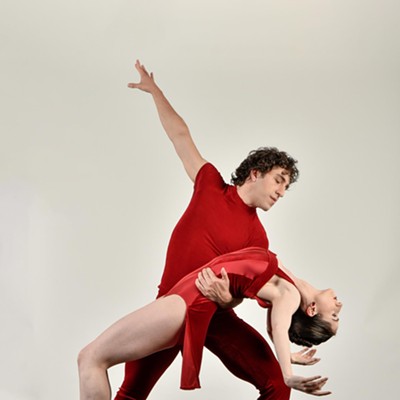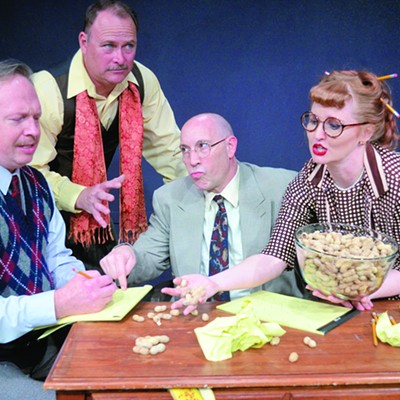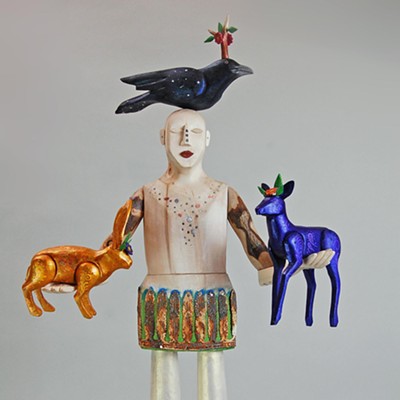WILLING TO READ
Friday, Jan. 16, 7:30 p.m.Reader's Oasis
3400 E. Speedway Blvd.
319-7887
Back in 1992, a sextet of women, newly graduated from UA's creative writing program, formed what became known dully as "The Writing Group." The six writers were anything but dull. They soon became known as the Daybreak and Willingness Club, borrowed from a line in a poem written by group member Lisa Cooper. It's also the name of their self-titled chapbook that debuted a few years ago.
Cooper, along with Barbara Allen, Janice Dewey, Karen Falkenstrom, Rita Maria Magdaleno and Barrie Ryan, open their journals and organize tattered sheets of paper to reveal their individual creations, reading early and brand-spanking-new material.
In more than a decade of existence, the group has seen ups and downs and personnel changes. But it's consistently served as a vehicle through which its members introduce new ideas and generate new work--within the context of current events and their own personal lives.
All the group members live, work and create art in Tucson. Come hear their literary gems. The reading is free.
WALKING WITH GHOSTS
Saturday, Jan. 17 and Monday, Jan. 19, 10 a.m.KruseArizona Tours
881-1638
What is it about us living humans who like to stroll over the bodies of dead ones? Count myself among them (the living ones) who are intrigued by gravestones, cemeteries and anything funereal. (I'm particularly enthralled with pet cemeteries, but that's another story.)
Glean all you can from Alan Kruse and his famed tours. On Saturday, he offers a historical overview of Holy Hope Cemetery (3555 N. Oracle Road). He lets you loose over the gravesites after that. I'm sure he has a few stories to tell about interesting characters of historic Tucson lying beneath the fake plastic flowers. Meet at the circle just inside the main gate.
On Monday, the ghosts may or may not be buried below your sturdy walking shoes. But Barrio Historico is one of the oldest neighborhoods in the city, so there's bound to be a restless spirit floating around, particularly with all the cruising Beamers and Lexus automobiles barreling down the narrow streets these days with drivers pointing out the ubiquitous house renovations and new faux adobes. Kruse offers a glimpse of Hispanic cultural and architectural traditions in the 'hood. The tour focuses on homes built in the late 1880s on Convent Street and Sixth Avenue. Meet in the parking lot of Jerry's Lee Ho Market (600 S. Meyer Ave.).
Each tour costs $15 apiece and includes refreshments. Call for reservations.
GLASS PLANET
Saturday, Jan. 17, 2 to 3 p.m.Tucson Museum of Art
140 N. Main Ave.
624-2333, ext. 111
Josh Simpson and Cady Coleman are not your typical couple. Yes, they inspire each other's work. But what they do is a little less than conventional.
Simpson is an internationally acclaimed glass artist. Coleman is an astronaut. As you can imagine, science and art are the topic of dinner conversations--when the couple gets to dine together. Simpson lives in Massachusetts; Coleman hangs in Houston.
The Boston Globe describes them as the "cosmic couple," because Coleman and Simpson share an interest in space, and they both are private pilots.
When Simpson saw images sent back from space by the early astronauts, he was profoundly inspired to make art in their stead. His glass planets mesmerize those who behold them: beautiful spheres encasing whimsical scenes of other world surfaces. He adheres to astronaut Jim Lowell's comment that out of his spacecraft window, he could cover the Earth with his thumb. By creating planets that can be held in one's hand, Simpson has embodied the astronaut's view of our tiny spinning planet. Simpson's work lives in the permanent collections of museums around the world, including the Josh Simpson Sphere Museum in Yokohama.
Coleman's astronaut career started in 1992. She got her start in the Air Force and later served as a research chemist, surface analysis consultant and as a volunteer test subject for the centrifuge program. She's logged more than 500 hours in space, setting endurance and tolerance records. She can proudly boast that she deployed the Chandra X-Ray Observatory on her second mission aboard the space shuttle Columbia.
The cosmic couple share insight into their braided lives. Seating is limited, so make your reservations. If you can't make the lecture, join Simpson for an autographing of his new book on Saturday from 5 to 7 p.m. at Philabaum Glass Gallery, located at 4280 N. Campbell Ave. And if you still need a jolt of Josh Simpson, take in the PBS documentary, Where the Earth Meets the Sky, airing on KUAT-TV Channel 6 at 12:30 p.m. Thursday, Jan. 15; 4:30 p.m. Saturday, Jan. 17; and 10:30 a.m. Sunday, Jan. 18.
CERAMIC-A-RAMA
Saturday, Jan. 17, 10 a.m. to 4 p.m.Arizona State Museum
Inside UA Main Gate
Park Avenue and University Boulevard
626-2973
"Right now, the museum is all about pots," says Lisa Falk, the education director and event organizer. "We're in the process of building a new vault for our renowned pottery collection."
The museum is in the midst of its current exhibit, The Pottery Detectives, and it offers a monthly family program led by ceramic artists. Ceramic-A-Rama is another in the grab bag of all things ceramic.
While the 20,000 whole vessels and millions of partials and fragments in the museum's collection are hundreds, even thousands, of years old, the relevancy of today's ceramics are just as vibrant, inspiring and culturally significant, say museum staff.
"We want Ceramic-A-Rama to emphasize the point that just as in prehistoric times, ceramics are an important part of our lives," explains museum curator Suzanne Griset.
Just think "coffee mug."
The day's events include a show and sale of ceramic works by community artists. There's also hands-on fun. Make your own clay pot or a pot puzzle or draw a design and craft a 3-D paper pot. Test your knowledge of traditional Arizona pottery, and learn what trees reveal about how old a pot may be. Artists also demonstrate hand-building and wheel-throwing techniques. Stay and watch how they turn clay to ceramic in a trash-can firing. Don't miss a walk through the collections--sneak a peak at an 8-foot-tall pot and decode the secrets of Southwestern pottery. You're invited to be a pottery detective.
Call for details or visit www.statemuseum.arizona.edu.







